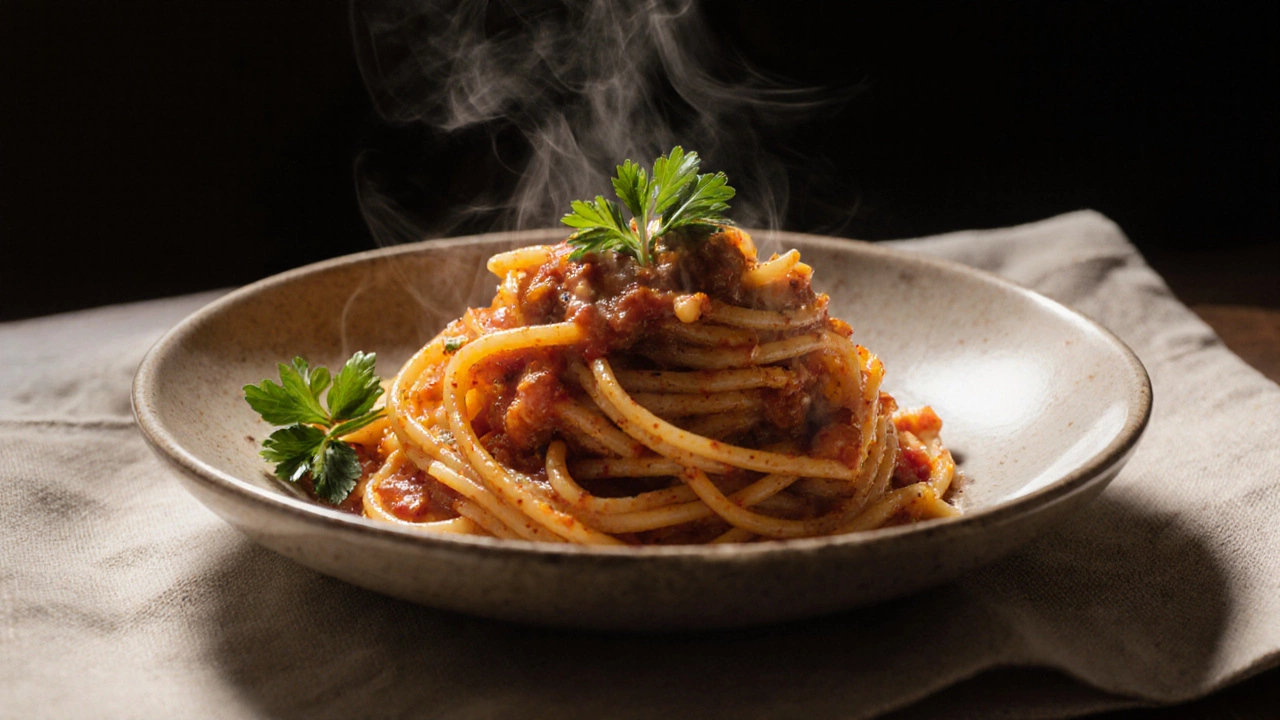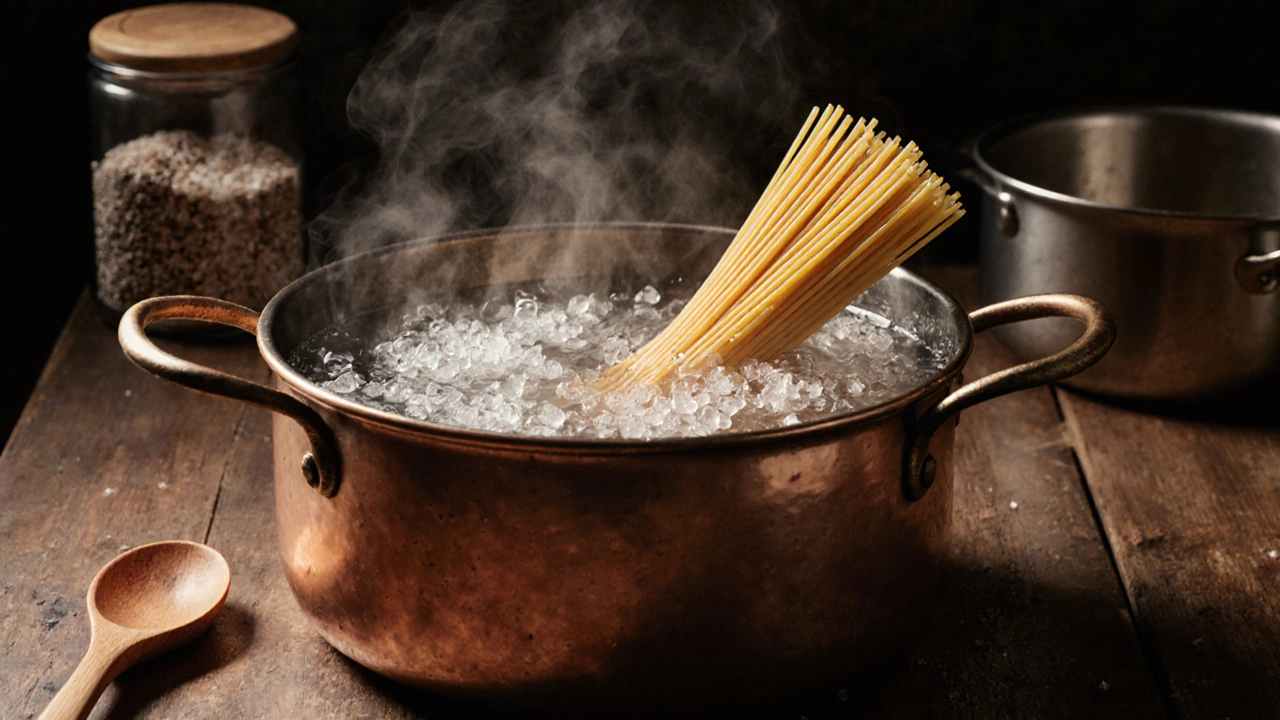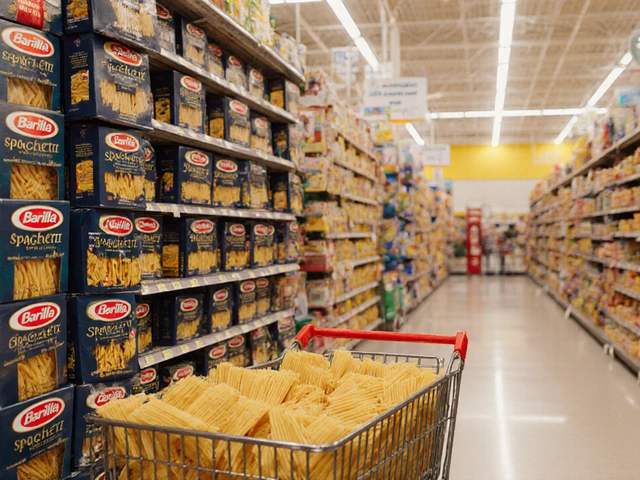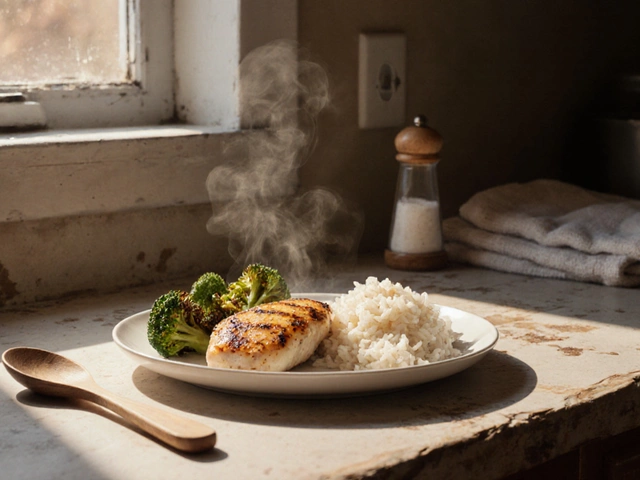Pasta Cooking Time Calculator
The secret to perfect pasta starts with proper timing. The article explains that pasta should be cooked 1-2 minutes less than package instructions to achieve al dente texture, as it continues cooking in the sauce.
Ideal Cooking Time
Why this matters: This timing ensures your pasta is al dente - firm to the bite - when it hits the sauce pan. Pasta continues cooking from residual heat, so undercooking slightly prevents mushiness.
Remember: Always reserve 1 cup of pasta water before draining. The starchy water helps bind sauce to pasta, creating that perfect emulsion restaurant chefs rely on.
Ever made pasta that was sticky, mushy, or bland-even when you followed the recipe? You’re not alone. Most people think good pasta is about the sauce. It’s not. The secret to good pasta starts the moment you drop it into the pot. And it’s not magic. It’s physics, salt, and patience.
Use Way More Salt Than You Think
The water you boil pasta in should taste like the sea. Not a pinch. Not a teaspoon. At least 1 tablespoon of coarse sea salt per 4 quarts of water. That’s about 1.5% salinity. Why? Because pasta absorbs water as it cooks, and with it, flavor. If your water is bland, your pasta will be too. No sauce can fix that.
Think of it like seasoning meat before grilling. You don’t wait until it’s cooked to add salt. Same rule here. The salt doesn’t make the pasta salty-it makes it taste like itself. A well-salted noodle has depth. It sings on its own. Add sauce later, and it becomes a harmony, not a mess.
Boil, Don’t Simmer
Big pot. Lots of water. Rolling boil. That’s non-negotiable. You need enough water so the pasta moves freely. Crowded pasta sticks, clumps, and cooks unevenly. Use at least 1.5 gallons for a pound of pasta. More is better.
A gentle simmer won’t cut it. The violent motion of a full boil keeps strands separated and ensures even hydration. It also sets the exterior just enough to prevent sticking. If your water stops boiling when you add the pasta, wait for it to return to a full boil before starting your timer. No shortcuts.
Don’t Add Oil to the Water
That old trick-drizzling olive oil into the pot to keep pasta from sticking? It doesn’t work. And it makes your sauce slide right off. Oil floats on top of the water. It never touches the pasta. All it does is create a greasy film that repels sauce. You’re not helping. You’re sabotaging.
If your pasta sticks, it’s because you didn’t use enough water or you stirred too little. Stir once or twice right after adding the pasta, then leave it alone. That’s all you need.
Cook It Until It’s Just Short of Done
Read the package. Then subtract 1 to 2 minutes. Pasta finishes cooking in the sauce. This is the single most overlooked trick in home kitchens. You’re not boiling pasta to be done in the pot. You’re boiling it to be *al dente*-firm to the bite-when it hits the pan with the sauce.
Why? Because pasta keeps cooking from residual heat. If you pull it out fully cooked, it turns to mush when you toss it with sauce. You want it to have a slight resistance in the center. That’s the texture professionals look for. That’s what makes you say, “This tastes like Italy.”
Reserve a Cup of Pasta Water Before Draining
That starchy, salty water isn’t waste. It’s liquid gold. When you drain the pasta, save at least one cup before pouring it out. You’ll use it to loosen and bind your sauce.
Here’s how: After you drain the pasta, toss it into the pan with your sauce over low heat. Add a splash of that reserved water-2 to 4 tablespoons at a time-and stir. The starch thickens the sauce, helps it cling to the noodles, and creates a silky emulsion. No cream. No butter. Just pasta water doing its job.
It’s why restaurant pasta always looks glossy and perfectly coated. They’re not using fancy ingredients. They’re using water they saved.

Sauce Should Be Ready Before the Pasta Is
Don’t make sauce while the pasta boils. Make it first. Keep it warm. Let it sit. That way, when the pasta hits the pan, everything comes together fast. Sauce needs time to meld. Pasta needs time to cook. Trying to do both at once leads to rushed, uneven results.
For example, if you’re making a simple aglio e olio, get your garlic sizzling in olive oil, your chili flakes toasted, your parsley chopped-all before the pasta hits the pot. When the noodles come out, you toss them in for 90 seconds. Done. Elegant. Perfect.
Same goes for tomato sauce, pesto, or carbonara. The sauce is the stage. The pasta is the star. You don’t let the star wait in the wings.
Finish Cooking in the Pan, Not the Pot
Never plate pasta straight from the colander. That’s how you get dry, separated noodles. Always finish cooking it in the saucepan. Let it simmer together for a minute or two. Stir constantly. Add pasta water as needed. The heat from the pan, the motion of stirring, and the starch in the water all combine to make the sauce and pasta become one.
This is the difference between “I made pasta” and “I made a dish.”
Use Bronze-Die Extruded Pasta When You Can
Not all pasta is made the same. Most supermarket pasta is made with Teflon dies-smooth, fast, cheap. It looks perfect. But it’s slippery. Sauce slides right off.
Bronze-die pasta is extruded through copper molds that create a rough, porous surface. That texture grabs sauce like Velcro. It’s slower to make. More expensive. But it’s the only kind worth using if you care about quality. Look for “trafilata al bronzo” on the package. Brands like De Cecco, Rustichella d’Abruzzo, or Barilla’s bronze-extruded line are widely available.
It’s not about tradition. It’s about physics. Rough surface + starch = sauce that sticks.
Don’t Overdo the Cheese
Grated Parmesan or Pecorino? Great. But don’t dump it in like salt. A tablespoon or two stirred in at the end is enough. Too much cheese turns your pasta into a greasy, clumpy mess. It also masks the flavor of the pasta itself.
And skip the powdered stuff in the green can. It’s not cheese. It’s cellulose and flavor chemicals. Real cheese melts. Powdered cheese just sits there.

Let the Pasta Rest Before Serving
After you toss the pasta with sauce, let it sit for 30 seconds off the heat. Just a moment. This lets the flavors settle. The starches reabsorb. The sauce thickens slightly. It’s the final touch that turns good into great.
It’s the same reason chefs let steaks rest. It’s not about temperature. It’s about integration.
What About Gluten-Free or Whole Wheat?
Gluten-free pasta doesn’t have to be gummy. Same rules apply: salted water, plenty of room, don’t overcook, finish in the sauce. But gluten-free pasta cooks faster. Check it 2 minutes before the package says. It goes from undercooked to mushy in seconds.
Whole wheat pasta has more fiber, more flavor, and a nuttier bite. But it also absorbs more water. Use a little extra sauce. And don’t expect it to be as smooth as white pasta. It’s not supposed to be. It’s heartier. Own it.
What About Fresh Pasta?
Fresh pasta cooks in 2 to 4 minutes. It’s delicate. Use less water-just enough to cover. Stir gently. Don’t salt it as heavily. The dough already has salt in it. Finish it in the sauce. That’s it.
It’s not harder. It’s just faster. And it’s more forgiving if you’re not perfect with timing.
Final Thought: It’s Not the Sauce
The secret to good pasta isn’t in the sauce. It’s in the water. In the salt. In the timing. In the patience. A perfect bowl of spaghetti with just garlic, olive oil, and chili flakes can be better than a rich ragù made with bad noodles.
Good pasta isn’t an accident. It’s a practice. Master the basics, and you’ll never need a recipe again.
Should I rinse my pasta after cooking?
No. Rinsing removes the starch that helps sauce cling to the pasta. Only rinse if you’re making a cold pasta salad. For hot dishes, drain and toss straight into the sauce.
Why does my pasta stick together?
It sticks because you didn’t use enough water, didn’t stir at the start, or overcooked it. Use at least 4 quarts of water per pound, stir once right after adding the pasta, and cook it al dente. Never add oil-it doesn’t help.
Can I cook pasta in less water?
You can, but you shouldn’t. Cooking pasta in a small amount of water makes it starchy and gummy. The pasta needs space to move so it cooks evenly. Stick to 1.5 gallons for a pound of pasta. It’s the only way to get consistent results.
What’s the best pasta shape for sauce?
It depends on the sauce. Long, thin pasta like spaghetti works with light oils or tomato sauces. Short, ridged shapes like rigatoni or penne hold chunky sauces. Flat ribbons like pappardelle are perfect for rich meat ragùs. Match the shape to the sauce texture, not just preference.
Is fresh pasta better than dried?
Fresh pasta is softer and more delicate, great for butter or light sauces. Dried pasta, especially bronze-die, has more structure and holds up to hearty sauces. Neither is better-it’s about the dish you’re making. Dried pasta is more consistent and easier to store.





